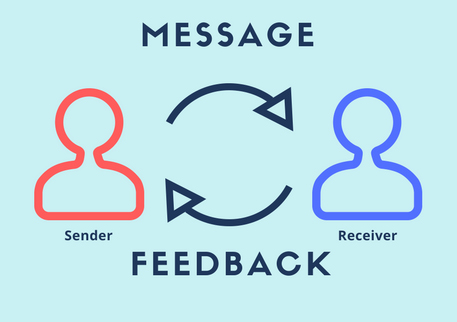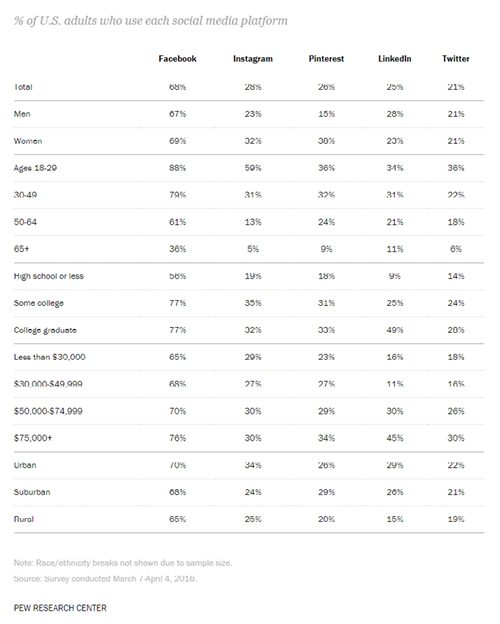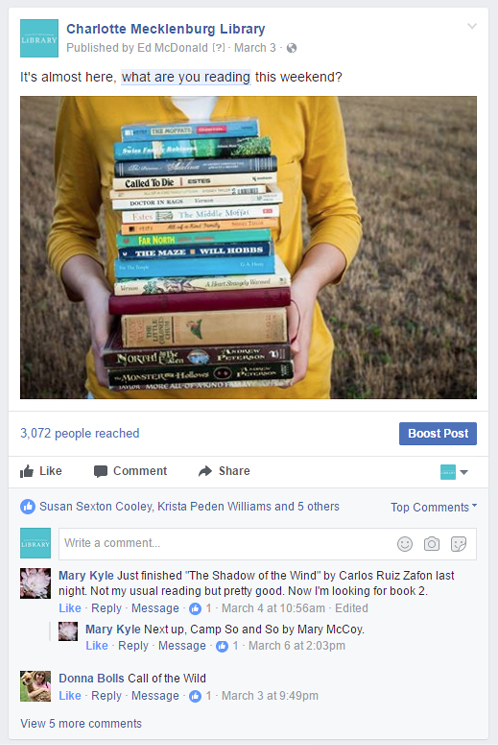Moving from a Promotion Strategy to an Engagement Strategy
Cordelia Anderson, APR, Director of Marketing and Communications for the Charlotte Mecklenburg Library, has nearly twenty years’ experience creating marketing and communications strategies for highly visible nonprofit, educational, and corporate organizations. Today, she leads her library’s public relations and marketing efforts with a team of talented professionals. Anderson has spoken at many meetings and conferences, including the American Library Association Annual Conference, Internet Librarian, Computers in Libraries, and the Public Relations Society of America’s local and Southeast chapter meetings. Connect with her at http://www.linkedin.com/in/cordeliaanderson.
Correspondence concerning this column should be directed to Nicole Eva and Erin Shea; email: nicole.eva@uleth.ca and eshea@fergusonlibrary.org.
Cordelia Anderson highlights the need to assess your patrons’ needs and personalities to appeal to them, rather than simply pushing your message out there and hoping something sticks. Engagement requires more effort on our part, but ultimately is much more rewarding as well. Read on for some great ideas on how to fine-tune your promotions and turn them into opportunities for real engagement with your community members.—Editors
We all want the same thing: To get more people to use more library services more often, and bring their friends. But our efforts to promote services and programs don’t always give us the results we want. Why? I would argue that we spend too much time and energy on promotion and not enough on engagement.
Engage in a Two-Way Conversation
As an individual, would you rather have someone stand in front of you, talking to you through a megaphone about all the great things they can do for you? Or would you rather have them sit next to you, ask you about your needs, listen to your response, and then suggest ways they can help?
Too often, when we talk about promoting libraries, the strategy resembles the megaphone. Tell as many people as you can as many things as you can about your library.
Engagement resembles the two-way conversation, and though it requires more effort, it yields better results (see figure 1).
Examples of engagement strategies include the following:
- Active listening. This means monitoring all your social media spaces on a daily basis to see what people are talking about and answer their questions. If you really pay attention, you can even anticipate their questions before they ask.
- Customer feedback. How do you gather feedback from your library users? Surveys? Focus groups? Across-the-desk comments? Online reviews (Yelp, Facebook, etc.)? Make sure you are always gathering feedback, reviewing it, and using it to improve your services and programs. This will help you be more targeted in your marketing efforts as well.
Whether you use one of these strategies or something different, if you ensure that it’s a two-way conversation, you will move from promotion to engagement.
Flip the Narrative
Do you think the person you are communicating with sees themselves as a character in your library’s story? Of course not! They are the main character in their story, but you have a role too. You can help them on their journey and be a part of getting them where they need to go. So stop telling your story—tell their story. Help them see how your library gets them to their happy ending.
This doesn’t mean you have to throw out everything you’re doing—often it’s just a matter of flipping the narrative. Instead of saying, “The Library’s summer reading program helps children prepare for kindergarten,” flip it to say, “Briana, age 5, is ready for kindergarten after participating in our summer reading program.”
Examples of storytelling strategies include the following:
- Stories of impact. Instead of talking about yourself, tell the story of a person whose life was changed because of a library program or service. When you make it about people, it allows your audiences to picture themselves being helped by the library. These can be as simple as social media posts or as elaborate as videos—just make sure they are compelling and visual.
- Photography. When marketing a program or service, use a strong visual of a person using that service. You can either use real customer photographs or stock photography, as long as they tell a visual story. And don’t always use people who look the same—diversity allows more people to see themselves using your library service. See figure 2.
- Statistics. Not everyone responds to numbers, but combined with visuals and stories, statistics can be very compelling because they show how many people are engaging with your library. So, using Briana again, we could add, “There are 15,000 children starting kindergarten this year, and Briana, age 5, is one of them. Emily’s mother, Sandra, said that summer reading helped Briana and many of her classmates get ready for kindergarten.”
And speaking of large numbers . . .
Emphasize Quality over Quantity
Now you have compelling stories and you’re ready to engage with your audiences. The more channels you have to tell these stories through, the better, right?
Actually, no. That’s like saying the more plants you have, the better your garden will be. But just like in gardening, each channel—whether it be Facebook, Twitter, a blog, or something else—requires careful tending. If you have too many, you can’t manage them, and they can fall into disuse or neglect. Carefully select a few channels, focusing on what you can manage and where your customers are.
Not sure which channels are best for your audiences? See figure 3 for a quick reference.
When Facebook and Twitter first became popular back in the mid-2000s, staff at my Library were excited about these as promotion tools. We often heard this refrain: “We can use these tools to promote our programs!” And suddenly, all our programs were filled, right? And the more social media channels we added, the more we were overrun with people, right?
Sadly, no. It wasn’t until we reduced the number of social media channels we were using and moved from a promotion strategy to an engagement strategy that our followership began to grow. It grew because with fewer channels, we could post higher-quality content, geared toward our audiences, with greater frequency. Also, we were no longer competing with ourselves. If a library lover wanted to connect with us, they only had to go to one or two places instead of a dozen or more.
As we adapt to new tools in the changing social and technology landscape, the need for personal human connection does not go away. If you approach social media as a way to connect with people, as a two-way conversation, as a place for engagement, your audience will grow. And you will build a community of followers, supporters, and brand ambassadors that are loyal.
Examples of social media engagement strategies include the following:
- Downsizing social media. Take a long, hard look at the statistics for your social media sites. How often are they updated? Less than once a week? How many people are visiting? A few people a month? If the content isn’t fresh, or nobody is seeing it, or both—it’s time to let go. Post a message to let followers know when it’s closing—and refer them to another place where they can follow you.
- Asking a simple question. One of the most popular posts on our Facebook page is, “What are you reading this weekend?” People love to respond, and swap book recommendations with others in the thread. We have used this many times, and it still works! Try pairing it with a photo that is topical. For example, if it’s raining, use a photo of a book next to a rain-soaked window. See figure 4.
- Targeted boosting. On Facebook, you can boost a post to a targeted audience for as little as $5. The more you target your audience, the more effective it will be. For example, we once had a Game of Thrones–related program, and we targeted Facebook users who lived in our county and liked Game of Thrones. The boosted post drew new people to our page and the program.
So now that you are using social media and other tools to connect and engage with customers, what happens when that program or service just isn’t getting the usage you want?
Know When to Stop
The definition of marketing is “the science of understanding human wants and needs and designing services to meet those needs.” This is possible when you are listening to the wants and needs of your customers.
This often happens quite effectively in our libraries, without a lot of arduous research. A librarian notices that biographies are popular and creates a display of biographies. These books get checked out. A staff person notices a lot of people coming into the library for résumé help, and organizes a résumé class. It is well attended.
Where it gets more complicated is when we are promoting programs or services that didn’t arise in response to a need, are new or different, or whose audience has moved on. And, if you work in libraries, you know—we have a hard time letting go.
We often respond with a lot of printed material in the form of flyers, brochures, posters, etc. Printed material is not bad—in fact, it’s probably the best way that people who are already in your branch learn about new programs or services. Where it becomes ineffective is when it isn’t part of a larger marketing strategy. Throwing a lot of flyers at a program or service that isn’t being used may not solve the problem.
It may be more effective to look at the audience for that program or service, and determine whether they really want or need it. Perhaps their needs are being met in some other way. And that’s OK.
Here are some examples of things that can be stopped:
- Print newsletters. Years ago, we produced a monthly newsletter listing all our programs for that month. Yes, some people read it, but we had no demonstrable evidence that it was bringing more people in. Furthermore, we were recycling hundreds of them at the end of each month. We discontinued the newsletter, and instead designed a suite of calendar and flyer templates for branch staff to use. That put the power in their hands, and saved a lot of time and money.
- Poorly attended programs. Sometimes it’s hard to determine why a program is not well attended. The easiest way to find out is to ask your customers. Are they interested, but didn’t know about it? Or did they know about it, but weren’t interested? Or was the time or location not right for them? Instead of starting with the program, start with the customer. If they don’t want it, stop doing it!
- “One size fits all.” It may be that one program is best promoted through word-of-mouth, while another service is best promoted on social media. Don’t feel locked in to a set way of marketing things. Not every event needs a press release, and not every service needs to be on Twitter. See what works best, and do more of that.
So, although marketing is a science, you don’t have to be a scientist to do it effectively. When you embrace the two-way conversation, make the customer the focus of the narrative, provide high-quality content, and let go of things that are not working, you are on the road to better customer engagement.

Figure 1. Basic Communication Model

Figure 2. Example of a stock photo used to promote Freading

Figure 3. Pew Research Center Social Media Fact Sheet. Source: http://www.pewinternet.org/fact-sheet/social-media/.

Figure 4. Example of a popular “what are you reading?” Facebook post